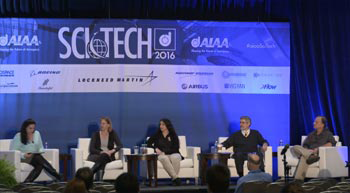Educators Incorporate Engineering Principles Into Student Learning Written 7 January 2016
Panelists: Moderator Meredith Drosback, assistant director for education and physical sciences, Office of Science and Technology Policy, Executive Office of the President; Edward J. Coyle, John B. Peatman distinguished professor of electrical and computer engineering, Georgia Institute of Technology; Kirsten Fogg, STEM engagement lead, NASA’s Armstrong Flight Research Center; Kurt Long, aerospace engineer, Experimental Aero-Physics Branch, NASA’s Ames Research Center; Thea Sahr, director of programs, DiscoverE
by Hannah Thoreson, AIAA Communications

Engineering principles can be challenging to incorporate into student learning, but educators and engineers who participated in a panel Jan. 7 at the 2016 AIAA Science and Technology Forum and Exposition in San Diego have ideas about how to encourage more engineering thinking in learning environments.
“The next generation of STEM workforce is critical to maintaining the nation’s leading role in an increasingly competitive world economy,” said Meredith Drosback, assistant director for education and physical sciences with the Office of Science and Technology Policy at the White House, as she kicked off the “Putting the ‘E’ in STEM” panel.
Thea Sahr, director of programs at DiscoverE, gave her organization’s Future City competition as an example of a hands-on project that teaches students engineering skills.
“There’s been more of a movement to get more project-based learning into schools,” she said.
Kirsten Fogg, STEM engagement lead with NASA’s Armstrong Flight Research Center, and Kurt Long, an aerospace engineer with the Experimental Aero-Physics Branch of NASA’s Ames Research Center, also stressed the need to give students hands-on projects with real design constraints.
“We try to develop programs that get that hands-on experience into the classroom, whether it’s K-12 or college-based,” Fogg said.
Long emphasized the importance of internships as well as hands-on projects.
"The way you learn and become a good engineer is to fail,” he said. “We want students to get that experience of failing and learning from their mistakes.”
At Georgia Tech, there are difficulties to getting more undergrads to assist in research, according to Edward J. Coyle, a professor in the School of Electrical and Computer Engineering at the school. He cited institutional barriers, such as the semester-based academic calendar and divisions between academic departments. Despite those barriers, Coyle has incorporated students into his research.
“If you create something of interest to people, they’ll want to be engineers,” he said.
